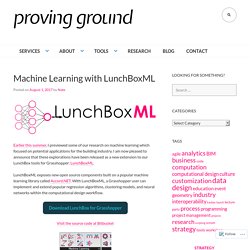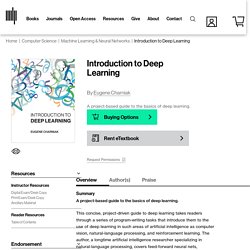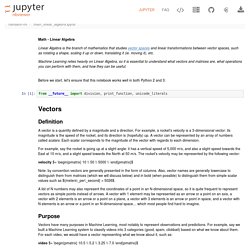

Index.
Data Mining with Weka. Machine Learning with LunchBoxML – PROVING GROUND. Earlier this summer, I previewed some of our research on machine learning which focused on potential applications for the building industry.

I am now pleased to announce that these explorations have been released as a new extension to our LunchBox tools for Grasshopper: LunchBoxML. LunchBoxML exposes new open source components built on a popular machine learning library called Accord.NET. With LunchBoxML, a Grasshopper user can implement and extend popular regression algorithms, clustering models, and neural networks within the computational design workflow. Download LunchBox for Grasshopper Visit the source code at Bitbucket Why Machine Learning? A great deal of mystique and hype surrounds the term ‘machine learning’. The reality of machine learning is much more practical…even a little mundane.
Simply put, machine learning is about creating an algorithm that can learn from some quantified ‘experience’ so it can then make predictions based on this experience. Like this: Like Loading... Introduction to Deep Learning. “We have a choice of a variety of books on deep learning: books on the theory written by expert academics, and practical books written by programmers.

This book gives you the best of both: Charniak is a prominent academic researcher who has been through every phase of artificial intelligence, often as a leader in ushering in a new phase. And he remains an active programmer who understands by doing. In this masterfully executed book he shows you what he has come to understand, allowing you to follow the code step by step, and also learn from his informed conclusions.”Peter NorvigResearch Director, Google “A wonderful book filling the yawning gap between the existing comprehensive 'bible' (by Goodfellow, Bengio, and Courville) and the many books aimed at industry practitioners.
This approachable volume provides clear, engaging writing describing the theory and practical implementation of the key deep learning algorithms across vision, NLP, and robotics. Foundations of Machine Learning, Second Edition. Deep Learning. “Written by three experts in the field, Deep Learning is the only comprehensive book on the subject. It provides much-needed broad perspective and mathematical preliminaries for software engineers and students entering the field, and serves as a reference for authorities.” —Elon Musk, cochair of OpenAI; cofounder and CEO of Tesla and SpaceX “This is the definitive textbook on deep learning. Written by major contributors to the field, it is clear, comprehensive, and authoritative. If you want to know where deep learning came from, what it is good for, and where it is going, read this book.” “Deep learning has taken the world of technology by storm since the beginning of the decade.
A framework for generating and evaluating façade designs using a multi-agent system approach - Evangelos Pantazis, David Gerber, 2018. Machine Learning Yearning. Deep Learning. 10 Free Must-Read Machine Learning E-Books For Data Scientists & AI Engineers. Ageron/handson-ml: A series of Jupyter notebooks that walk you through the fundamentals of Machine Learning and Deep Learning in python using Scikit-Learn and TensorFlow. Project Jupyter.
Ageron/handson-ml: A series of Jupyter notebooks that walk you through the fundamentals of Machine Learning and Deep Learning in python using Scikit-Learn and TensorFlow. Jupyter Notebook Viewer. Definition¶ A vector is a quantity defined by a magnitude and a direction.

For example, a rocket's velocity is a 3-dimensional vector: its magnitude is the speed of the rocket, and its direction is (hopefully) up. A vector can be represented by an array of numbers called scalars. Each scalar corresponds to the magnitude of the vector with regards to each dimension. For example, say the rocket is going up at a slight angle: it has a vertical speed of 5,000 m/s, and also a slight speed towards the East at 10 m/s, and a slight speed towards the North at 50 m/s. Velocity $= \begin{pmatrix} 10 \\ 50 \\ 5000 \\ \end{pmatrix}$ Note: by convention vectors are generally presented in the form of columns. A list of N numbers may also represent the coordinates of a point in an N-dimensional space, so it is quite frequent to represent vectors as simple points instead of arrows.
Purpose¶ Creative Applications of Deep Learning with TensorFlow, an Online Course at Kadenze. Creative Applications of Deep Learning with TensorFlow. Refikanadolstudio. Introduction to Computational Thinking and Data Science. New Machine Learning Examples with LunchBoxML – PROVING GROUND. What is Machine Learning? - Stanford University. What is Machine Learning? - Stanford University. Owl.